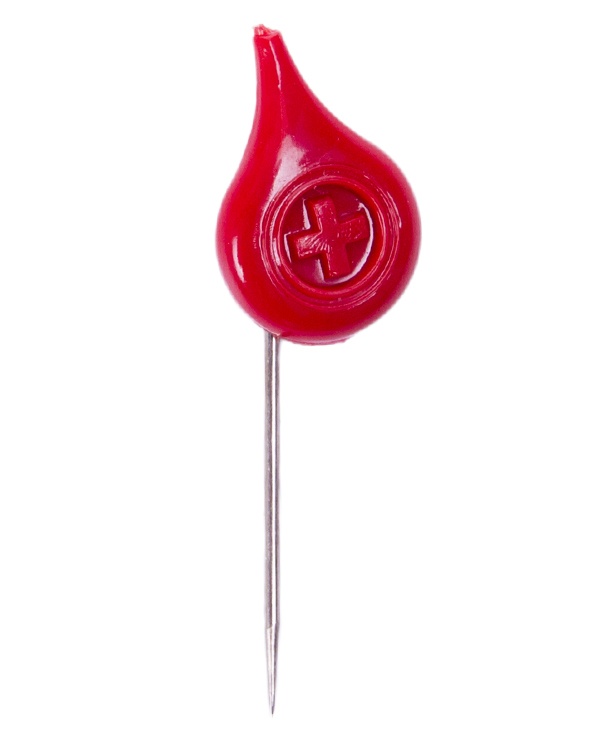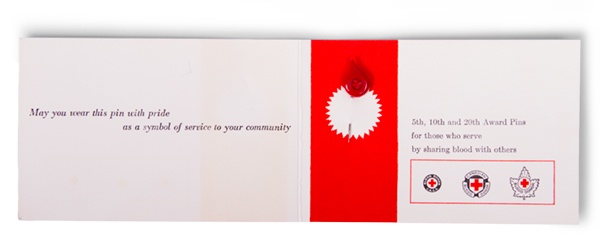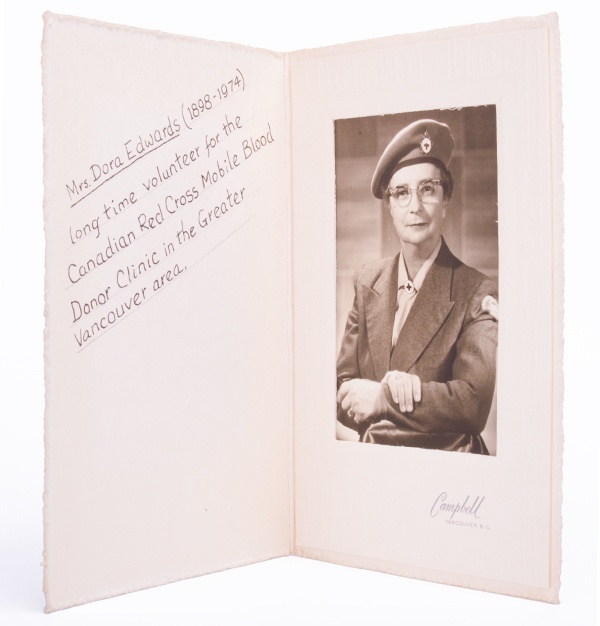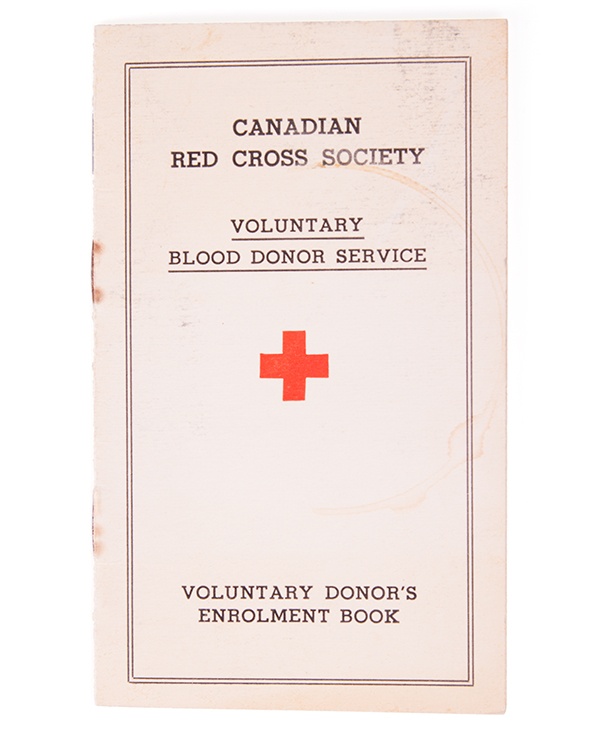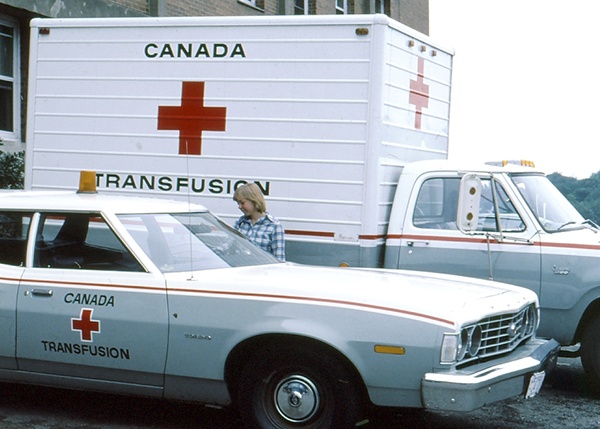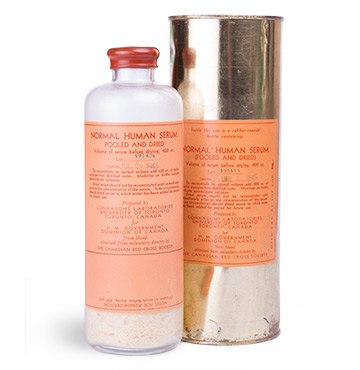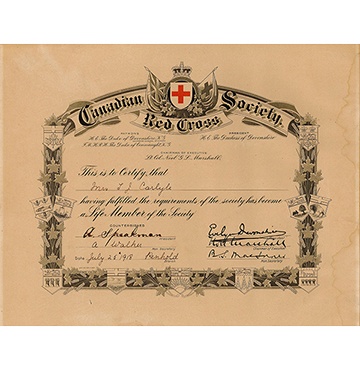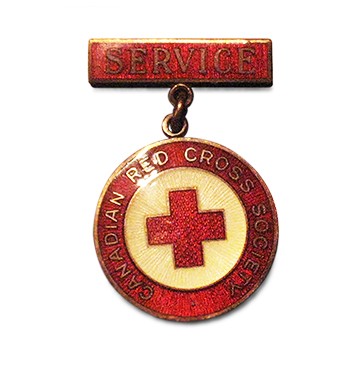Canadian Red Cross Blood Donor Pin
When the Second World War (1939-45) came to an end, the Canadian Red Cross entered its second major period of peacetime activity. One of the most important new programs it created in the early postwar years was the Blood Transfusion Service. Blood donor pins like the one shown here from 1947 identified and honoured those who donated their blood to save the lives of others.
The technology for successful blood transfusion experienced major advances during and after the First World War (1914-18), so that by the late 1930s most large urban hospitals had established their own small blood banks. This was no help, however, to citizens who did not live in these cities, or who could not afford the high fees charged for blood. The limited supply of blood also hindered the development of new therapeutic uses.
During the Second World War, the Canadian Red Cross played a central role in the collection of civilian blood for military use. The wartime venture was so successful that by 1945 it seemed an obvious step to create a peacetime blood system for the benefit of all Canadians. Procuring sufficient volunteer donors would be an ongoing challenge, but techniques pioneered during the war (like blood donor pins) would help, as would the inherent humanitarian appeal of helping to save lives.
“No price tag on blood.”
It required a monumental effort to negotiate agreements with every single hospital in Canada, procure and pay trained doctors, nurses, and technicians, and build collection and processing facilities. The creation of publicly-funded hospital insurance, and then Medicare, in the late 1950s/1960s, provided vital government support through cost-sharing agreements.
The first peacetime blood clinic opened in Vancouver in February 1947; it took another 14 years to achieve national coverage. But by 1961 Canadians had a comprehensive nationwide system through which they gave -- and received -- blood for free. Postwar Canadian Red Cross National Commissioner Dr. William Stuart Stanbury believed the lifesaving potential of blood was so powerful that there should be “no price tag on blood.” His vision and hard work gave birth to Canada’s first peacetime free blood transfusion system.
Although the Red Cross ended its involvement in the Canadian blood system in 1997-98, the not-for-profit model it established remains central to blood collection in this country.
When the Second World War (1939-45) came to an end, the Canadian Red Cross entered its second major period of peacetime activity. One of the most important new programs it created in the early postwar years was the Blood Transfusion Service. Blood donor pins like the one shown here from 1947 identified and honoured those who donated their blood to save the lives of others.
The technology for successful blood transfusion experienced major advances during and after the First World War (1914-18), so that by the late 1930s most large urban hospitals had established their own small blood banks. This was no help, however, to citizens who did not live in these cities, or who could not afford the high fees charged for blood. The limited supply of blood also hindered the development of new therapeutic uses.
During the Second World War, the Canadian Red Cross played a central role in the collection of civilian blood for military use. The wartime venture was so successful that by 1945 it seemed an obvious step to create a peacetime blood system for the benefit of all Canadians. Procuring sufficient volunteer donors would be an ongoing challenge, but techniques pioneered during the war (like blood donor pins) would help, as would the inherent humanitarian appeal of helping to save lives.
“No price tag on blood.”
It required a monumental effort to negotiate agreements with every single hospital in Canada, procure and pay trained doctors, nurses, and technicians, and build collection and processing facilities. The creation of publicly-funded hospital insurance, and then Medicare, in the late 1950s/1960s, provided vital government support through cost-sharing agreements.
The first peacetime blood clinic opened in Vancouver in February 1947; it took another 14 years to achieve national coverage. But by 1961 Canadians had a comprehensive nationwide system through which they gave -- and received -- blood for free. Postwar Canadian Red Cross National Commissioner Dr. William Stuart Stanbury believed the lifesaving potential of blood was so powerful that there should be “no price tag on blood.” His vision and hard work gave birth to Canada’s first peacetime free blood transfusion system.
Although the Red Cross ended its involvement in the Canadian blood system in 1997-98, the not-for-profit model it established remains central to blood collection in this country.

